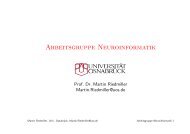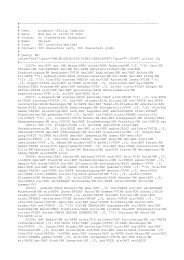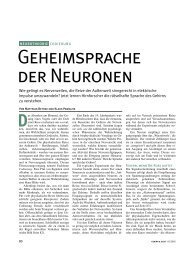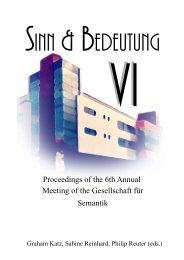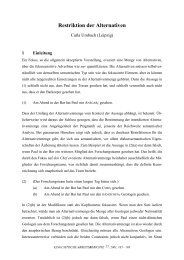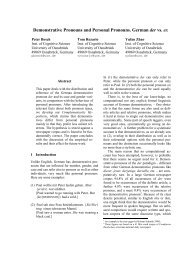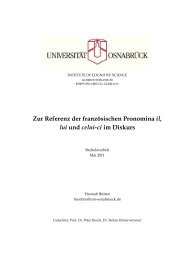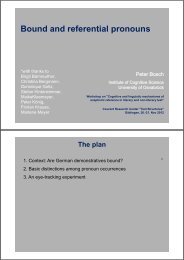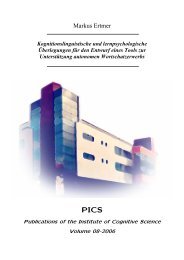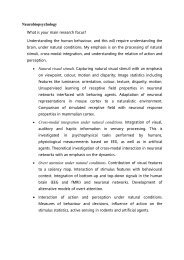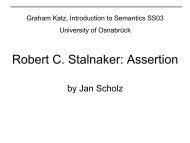Two systems of anaphorically used pronouns in plain text and in ...
Two systems of anaphorically used pronouns in plain text and in ...
Two systems of anaphorically used pronouns in plain text and in ...
You also want an ePaper? Increase the reach of your titles
YUMPU automatically turns print PDFs into web optimized ePapers that Google loves.
3.1 Quantitative f<strong>in</strong>d<strong>in</strong>gs<br />
somewhat surpris<strong>in</strong>g frequency figures (only <strong>pronouns</strong> referr<strong>in</strong>g to entities, not to clauses<br />
or propositions; generally no neuter forms counted):<br />
(1)<br />
188 d-<strong>pronouns</strong><br />
190 k-<strong>pronouns</strong><br />
25 s-<strong>pronouns</strong><br />
→ it is the s-pronoun that is the marked member <strong>and</strong> that needs a particular explanation!<br />
3.2 Qualitative analysis<br />
d-<strong>pronouns</strong>, typical example (Geyer 2003, ex. 1-69, transcription simplified)<br />
(2) ... is a glans maadlë dabai gveesn dii is nauf und nundëgl<strong>of</strong>m<br />
‘... ist e<strong>in</strong> kle<strong>in</strong>es Mädchen dabei gewesen, die ist h<strong>in</strong>auf- und h<strong>in</strong>untergelaufen’<br />
‘... a little girl took part, she ran up <strong>and</strong> down’<br />
k-<strong>pronouns</strong>, typical example (Geyer 2003, ex. 7-53ff, transcription simplified)<br />
(3) no håd=s doch dsvaa nefm und dii håm=s/ imë gsåchd jaa unë feënseedaame vii=s<br />
nåchë haamghumë sen håm=si=s abl rechd dsum naën ghaldn<br />
‘da hat sie doch zwei Neffen und die haben sie/ immer gesagt ja unsere Fernseh<br />
dame als sie dann nach Hause gekommen s<strong>in</strong>d haben sie sie immer recht zum<br />
Narren gehalten’<br />
‘so she’s got two nephews <strong>and</strong> they called her/ <strong>used</strong> to say oh our TV-lady when<br />
they came home then, they always made a fool <strong>of</strong> her’<br />
cf. also (4) (Geyer 2003, ex. 2-1ff, transcription simplified)<br />
(4) also guud dåå våë a mõõ und deë håd biën grisn und also deë våë seë schdolds<br />
auf sai biën und dan håd=ë an ghoëb ...<br />
‘also gut da war e<strong>in</strong> Mann und der hat Birnen gerissen (‘gepflückt’) und also der<br />
war sehr stolz auf se<strong>in</strong>e Birnen und dann hat er e<strong>in</strong>en Korb...’<br />
‘well, there was a man <strong>and</strong> he was pick<strong>in</strong>g pears <strong>and</strong> well he was very proud<br />
<strong>of</strong> his pears <strong>and</strong> then he [had] a basket…’<br />
Ma<strong>in</strong> difference <strong>in</strong> the <strong>in</strong>formation structural value <strong>of</strong> the respective referents:<br />
cf. Lambrecht 1994: 109 (“identifiable” branch only):<br />
(5)<br />
identifiable<br />
<strong>in</strong>active accessible active<br />
<strong>text</strong>ually situationally <strong>in</strong>ferentially<br />
2



